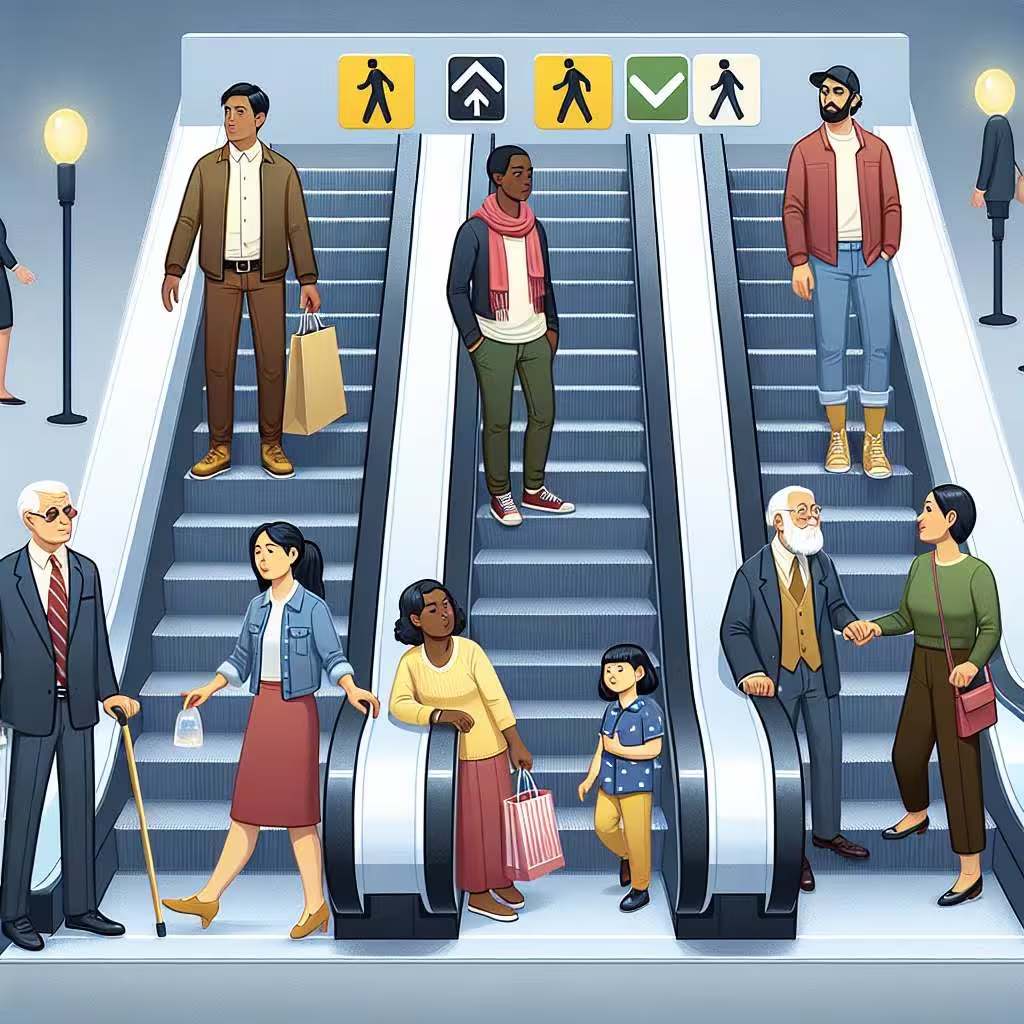As a designer of intermediate spaces, I’ve witnessed firsthand how escalators can evoke a range of emotions in people. These moving staircases, while ubiquitous in our urban landscapes, often trigger unexpected reactions that impact our daily experiences. Understanding and addressing these emotions is crucial for creating more inclusive, comfortable environments. By exploring the psychological aspects of escalator use, we can transform these transitional spaces into opportunities for personal growth and enhanced well-being.
Reader Disclosure
Jump to:
The Emotional Landscape of Escalators
Escalators, despite their seemingly mundane nature, can elicit a surprising array of negative emotions. These feelings often stem from deep-seated fears, past experiences, or even societal pressures. Let’s delve into the most common negative emotions associated with escalators and their potential origins.
Fear and Worry
For many, stepping onto an escalator triggers an immediate surge of fear or anxiety. This reaction can range from mild discomfort to full-blown panic attacks. The root causes of this fear are diverse:
- Fear of heights: Even though escalators are typically not very tall, the sensation of movement combined with a view of the ground below can trigger acrophobia.
- Fear of falling: The transition between solid ground and the moving steps can create a momentary loss of balance, leading to a fear of falling.
- Claustrophobia: In crowded spaces, the confined nature of an escalator can trigger feelings of being trapped.
- Past traumatic experiences: A previous accident or near-miss on an escalator can leave lasting emotional scars.
Embarrassment and Self-Consciousness
Social anxiety often manifests in public spaces, and escalators are no exception. Common sources of embarrassment include:
- Difficulty with balance: Some people feel self-conscious about their ability to step on or off the escalator smoothly.
- Clothing malfunctions: Concerns about long coats, loose shoelaces, or other items getting caught in the machinery.
- Personal space invasion: In crowded situations, the close proximity to strangers can be uncomfortable.
Frustration and Impatience
While escalators are designed to make our lives easier, they can sometimes have the opposite effect:
- Slow-moving traffic: When people stand still on escalators, it can create bottlenecks and frustrate those in a hurry.
- Mechanical failures: Broken escalators that become temporary staircases can disrupt our routines and cause annoyance.
- Accessibility issues: For those with mobility challenges, escalators can present significant obstacles.
What You’re Missing Out On
By allowing negative emotions to dominate our escalator experiences, we’re missing out on numerous potential benefits:
- Efficiency and convenience: Escalators are designed to make vertical transportation easier and faster, especially in busy urban environments.
- Opportunities for mindfulness: The brief journey on an escalator can be a moment for reflection and presence.
- Social interactions: Positive encounters with fellow travelers can brighten our day and foster a sense of community.
- Architectural appreciation: Many escalators are integral parts of impressive architectural designs, offering unique perspectives of buildings.
- Physical benefits: For those with mobility issues, escalators can provide a welcome alternative to stairs, promoting independence.

Embracing Positive Emotions
Instead of dwelling on negative feelings, we can shift our focus to the positive emotions that escalator use can cultivate:
Confidence and Empowerment
Mastering the use of escalators, especially for those who initially found them challenging, can be a significant confidence booster. This sense of accomplishment can extend to other areas of life, fostering a more positive self-image.
Curiosity and Wonder
Viewing escalators as marvels of engineering can spark curiosity about how things work. This mindset of wonder can enrich our daily experiences and encourage lifelong learning.
Gratitude and Appreciation
Recognizing the convenience that escalators provide can cultivate a sense of gratitude for modern amenities. This appreciation can extend to other aspects of our built environment, enhancing our overall quality of life.
Serenity and Calm
By reframing escalator rides as brief moments of respite in our busy days, we can use them as opportunities for mini-meditations or moments of calm.
Strategies for Emotional Transformation
Turning negative emotions into positive ones requires a combination of mindset shifts, behavioral changes, and social awareness. Here are some strategies to help you transform your escalator experiences:
Mindset Shifts
- Reframe the experience: Instead of viewing escalators as potential threats, see them as tools that make your life easier.
- Practice gratitude: Appreciate the engineering and convenience that escalators provide in your daily life.
- Embrace curiosity: Wonder about the mechanics and design of escalators, turning fear into fascination.
Behavioral Techniques
- Deep breathing: Use the duration of the escalator ride to practice calm, deep breaths, reducing anxiety.
- Positive affirmations: Repeat encouraging phrases to yourself as you approach and use the escalator.
- Gradual exposure: If you have severe anxiety, start with short escalator rides during off-peak hours and gradually increase duration and frequency.
Social Etiquette and Awareness
- Be considerate: Stand to one side to allow others to pass, reducing frustration for fellow travelers.
- Offer assistance: If you notice someone struggling, offer help (while respecting personal boundaries).
- Engage positively: Smile or nod at others, fostering a sense of shared experience and community.
Tracking Your Progress
Monitoring your emotional growth can be both motivating and insightful. Here are some ways to track your progress:
- Emotion journal: Keep a log of your feelings before, during, and after escalator use. Note any changes over time.
- Frequency tracking: Record how often you choose to use escalators versus alternatives like stairs or elevators.
- Physical symptoms: Pay attention to physical manifestations of anxiety (e.g., heart rate, sweating) and note any reductions.
- Positive experience tally: Count the number of pleasant or neutral escalator experiences you have each week.
- Challenge completion: Set small goals (e.g., using a specific escalator without hesitation) and celebrate when you achieve them.
Examples of Changeand Transformation
To illustrate how this emotional transformation can unfold, let’s consider a few examples:
- Sarah’s Story: Initially terrified of escalators, Sarah started by watching others use them comfortably. She then practiced on short escalators in quiet shopping centers. Over time, she progressed to using longer escalators in busier areas. Now, she confidently rides escalators in airports and metro stations, feeling a sense of accomplishment with each journey.
- Michael’s Journey: Michael used to feel intensely self-conscious on escalators, worried about tripping or looking awkward. He began focusing on his breathing and posture while riding. Gradually, he noticed he was spending less time worrying about others’ perceptions and more time appreciating the architecture around him. Today, he sees escalator rides as moments of mindfulness in his day.
- Elena’s Transformation: Frustrated by slow-moving crowds on escalators, Elena often felt her blood pressure rise during her commute. She decided to reframe these moments as opportunities to practice patience. She started listening to calming music or podcasts during her rides. Over time, she found herself more relaxed and even striking up friendly conversations with fellow commuters.
These examples demonstrate that with consistent effort and a positive mindset, it’s possible to not only overcome negative emotions associated with escalators but to transform these experiences into opportunities for personal growth and enhanced well-being.

People Also Ask
Are escalator accidents common?
Escalator accidents are relatively rare. According to the U.S. Consumer Product Safety Commission, there are approximately 17,000 escalator-related injuries per year in the United States. While this number may seem high, it’s important to consider the millions of escalator trips taken daily. Most accidents are minor and can be prevented by following safety guidelines.
How can I overcome my fear of escalators?
Overcoming escalator fear often involves gradual exposure therapy, cognitive-behavioral techniques, and relaxation methods. Start by observing escalators from a distance, then progress to standing near them, and finally to short rides during quiet times. Practicing deep breathing and positive self-talk can also be helpful. If your fear is severe, consider seeking help from a mental health professional specializing in phobias.
What’s the proper etiquette for using an escalator?
Proper escalator etiquette varies slightly by location, but generally:
- Stand to one side (usually the right) to allow others to pass.
- Hold the handrail for safety.
- Step on and off carefully, watching your step.
- Avoid blocking the entrance or exit.
- Keep loose clothing, shoelaces, and bags away from the steps and sides.
Are escalators environmentally friendly?
Escalators can be more energy-efficient than elevators for moving large numbers of people over short vertical distances. However, their constant operation can consume significant energy. Many modern escalators incorporate energy-saving features like sleep modes when not in use and regenerative braking systems. The environmental impact also depends on the building’s overall energy sources and efficiency measures.
Conclusion
Transforming our emotional experiences with escalators is more than just overcoming fear or frustration – it’s about embracing opportunities for personal growth and enhanced well-being in our daily lives. By shifting our mindsets, practicing mindfulness, and cultivating positive behaviors, we can turn these brief vertical journeys into moments of empowerment, curiosity, and connection. Remember, every step on an escalator can be a step towards a more positive, enriching life experience.
Show & Tell
We’d love to hear your thoughts about these ideas! Simply click the link to head over to your favorite platform and add your comments about this post there. We’d like to know about your insights, questions, or just saying hi.
Disclosure
Our content is reader-supported. This means if you click on some of our links, then we may earn a commission. Commissions do not affect our editor’s opinions or evaluations. Learn more about our editorial process.

About the Editorial Staff
The Curvspace editorial team comprises a diverse group of experts on intermediate and threshold spaces in homes and workplaces. Architects and interior designers, civil engineers and artists, environmental and behavioral psychologists, sociologists and anthropologists. All collaborate to create helpful content, that explores the full potential of these often-overlooked areas to enhance our daily lives.


